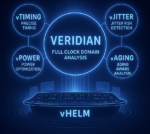At advanced nodes, the clock is no longer just another signal. It is the most critical and sensitive electrical network on the chip, and the difference between meeting performance targets and missing the tape-out often comes down to a few picoseconds, buried deep inside the clock distribution network. Yet many design teams still… Read More
Author: Mike Gianfagna
ClockEdge Delivers Precision, Visibility and Control for Advanced Node Clock Networks
A Tour of Advanced Data Conversion with Alphacore
There is always a lot of buzz about advanced AI workloads at trade shows. How to train them and how to run them. Advanced chip and multi-die designs are how AI is brought to life, so it was a perfect fit for discussion at a show. But there is another side of this discussion. Much of the work going on in AI workloads has to do with processing… Read More
I Have Seen the Future with ChipAgents Autonomous Root Cause Analysis
I have seen a lot of EDA tool demos in my time. More than I want to admit. The perceived quality of the demo usually came down to a combination of the speed of the tool, quality of results and the ease of navigating through the graphical user interface. For the last item, how easy the interface was on the eyes, how clear were the relationships… Read More
CDC Verification for Safety-Critical Designs – What You Need to Know
Verification is always a top priority for any chip project. Re-spins result in lost time-to-market and significant cost overruns. Chip bugs that make it to the field present another level of lost revenue, lost brand confidence and potential costly litigation. If the design is part of the avionics or control for an aircraft, the… Read More
A Six-Minute Journey to Secure Chip Design with Caspia
Hardware-level chip security has become an important topic across the semiconductor ecosystem. Thanks to sophisticated AI-fueled attacks, the hardware root of trust and its firmware are now vulnerable. And unlike software security, an instantiated weakness cannot be patched. The implications of such vulnerabilities are… Read More
PDF Solutions Charts a Course for the Future at Its User Conference and Analyst Day
Every major supplier has its user event. This is usually where the latest innovations from the company are revealed and progress over the past year is promoted. While there may be user presentations and exhibits, the primary focus is typically the vendor communicating its messages to the user base. The upcoming PDF Solutions Users… Read More
PDF Solutions Calls for a Revolution in Semiconductor Collaboration at SEMICON West
SEMICON West was held in Phoenix, Arizona on October 7-9. This premier event brings the incredibly diverse global electronics supply chain together to address the semiconductor ecosystem’s greatest opportunities and challenges. The event’s tagline this year is:
Stronger Together — Shaping a Sustainable Future in Talent,… Read More
Webinar – The Path to Smaller, Denser, and Faster with CPX, Samtec’s Co-Packaged Copper and Optics
For markets such as data center, high-performance computing, networking and AI accelerators the battle cry is often “copper is dead”. The tremendous demands for performance and power efficiency often lead to this conclusion. As is the case with many technology topics, things are not always the way they seem. It turns out a lot … Read More
Webinar – IP Design Considerations for Real-Time Edge AI Systems
It is well-known that semiconductor growth is driven by AI. That simple statement breaks down into many complex use cases, each with its own requirements and challenges. A webinar will be presented by Synopsys on October 23 that focuses on the specific requirements for one of the most popular use cases – AI at the edge. The speaker… Read More
Secure-IC and Silicon Labs Raise the Bar for Hardware Security
Cybersecurity is getting more critical every day. Thanks to sophisticated AI attacks, the need for hardware chip-level security is greater than ever. To fortify hardware against these types of attacks is not easy. There are three key attributes of a successful strategy: a well-designed root-of-trust, collaboration to ensure… Read More

















Jensen Huang Drops Donald Trump Truth Bomb on Joe Rogan Podcast